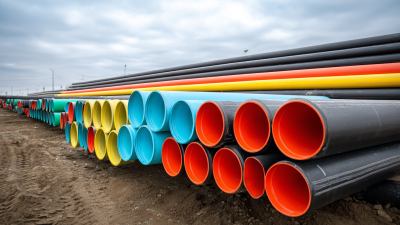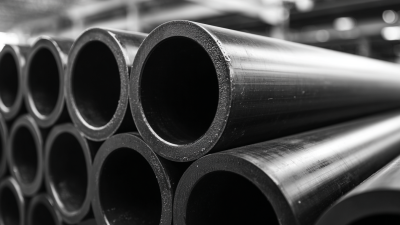-
Products and Systems
Products and Systems
Vinidex manufacturers and supplies a broad range of products & systems to suit a range of applications.
-
Solutions
Solutions
Vinidex’s products and systems are versatile and can be used in a variety of markets and applications.
- Resources
-
Exploring the Benefits of HDPE Pipe: Why Its Durability and Chemical Resistance Make It an Industry Standard

Dr. John Smith, a noted expert in polymer engineering, emphasizes the importance of HDPE pipe in modern applications, stating, “The exceptional durability and chemical resistance of HDPE pipes not only extend the lifecycle of infrastructure but also significantly reduce maintenance costs over time.” This testament underscores the material's resilience against corrosion and various chemicals, enabling its widespread use in environments that would typically compromise traditional piping systems. As industries continue to evolve and demand reliable solutions, the adoption of HDPE pipe stands as a testament to advancing engineering practices and sustainable resource management strategies.
Key Characteristics of HDPE Pipe: A Deep Dive into Durability and Chemical Resistance
High-Density Polyethylene (HDPE) pipes have established themselves as a prominent choice across various industries due to their remarkable durability and chemical resistance. With a global market projected to reach USD 25.68 billion by 2029, HDPE pipes are increasingly recognized for their ability to withstand harsh environmental conditions and corrosive substances. As municipalities and industries face growing infrastructure demands, the advantages of using HDPE in water supply, drainage, and other applications become even clearer.
One key characteristic of HDPE pipes is their exceptional longevity. Unlike traditional materials, HDPE does not corrode or rust, making it suitable for a wide range of uses, including wastewater management and agricultural irrigation. Furthermore, their resistance to various chemicals significantly reduces maintenance costs and extends overall lifespan. This durability ensures that industries can rely on HDPE pipes for efficient and sustainable operations over time.
Tips: When selecting HDPE pipes, consider factors such as the pipe's grade, wall thickness, and compatibility with the substances it will carry. Additionally, collaborating with suppliers who understand your specific needs can help ensure that you choose the right products for your projects. Always consult local regulations and industry standards to optimize performance and safety.
Comparing HDPE Pipe to Other Materials: Advantages and Limitations
When comparing HDPE (High-Density Polyethylene) pipe to other materials such as PVC (Polyvinyl Chloride) and steel, several significant advantages and limitations become apparent. HDPE pipe is known for its exceptional durability, boasting a lifespan of over 50 years in many applications, according to a report from the Plastic Pipe Institute. This long service life reduces the need for frequent replacements, resulting in lower overall costs for utilities and municipalities.
In terms of chemical resistance, HDPE outperforms many traditional materials, making it suitable for a wide range of industries, including agriculture, water distribution, and wastewater management. It can withstand aggressive chemicals and corrosive environments, as highlighted in a study by the American Society of Civil Engineers, which indicates that HDPE maintains integrity and performance under these conditions. However, while HDPE is superior in many aspects, it has limitations, particularly regarding temperature resistance, where materials like PVC can perform better in high-temperature situations. Thus, choosing the right material is essential based on the specific application requirements and environmental factors.
Applications of HDPE Pipe in Various Industries: Versatility in Action
HDPE (High-Density Polyethylene) pipes have established themselves as an essential component across various industries due to their remarkable durability and chemical resistance. These features make HDPE pipes an industry standard in applications ranging from water supply systems to gas distribution and wastewater management. Their resistance to corrosion and ability to withstand extreme temperatures ensure longevity and reliability, allowing industries to maintain efficient operations while minimizing maintenance costs.
The versatility of HDPE pipes is further evidenced by their utilization in different sectors such as construction, agriculture, and telecommunications. In construction, they provide a robust solution for drainage and plumbing systems, while in agriculture, they facilitate effective irrigation practices that enhance crop yields. The telecommunications industry benefits from HDPE pipes as well, utilizing them for cable conduits that protect vital communication lines. As the demand for sustainable and reliable infrastructure continues to grow, the HDPE pipes market is projected to reach USD 25.68 billion by 2029, highlighting the increasing recognition of their multifunctionality and resilience in diverse applications.
Environmental Impact of HDPE Pipe: Sustainability and Recycling Benefits
High-Density Polyethylene (HDPE) pipes are gaining significant attention not only for their mechanical properties but also for their environmental benefits, particularly in terms of sustainability and recycling potential. As industries increasingly shift toward eco-friendly materials, HDPE stands out due to its inherent chemical resistance and durability, which allows for a longer service life and reduced environmental footprint. The growing awareness of plastic waste has led to innovative recycling methods and an expanding market for recycled plastic pipes, projected to reach USD 21.1 billion by 2035, showcasing a remarkable growth trend.
Tips for businesses looking to adopt HDPE pipes include engaging with suppliers that prioritize sustainable practices and using recycled materials where possible. This not only contributes to environmental conservation but can also enhance brand reputation among eco-conscious consumers. Additionally, exploring innovations recognized by industry awards can provide insights into best practices in design and material usage, further promoting sustainability.
Moreover, embracing HDPE and recycled plastic options can also lead to cost savings in the long run due to lower maintenance requirements and the extended longevity of systems. As the market for HDPE pipes is projected to reach USD 25.68 billion by 2029, integrating these materials can position businesses advantageously within an evolving industry landscape focused on sustainability.
Exploring the Benefits of HDPE Pipe: Why Its Durability and Chemical Resistance Make It an Industry Standard - Environmental Impact of HDPE Pipe: Sustainability and Recycling Benefits
| Property | HDPE Pipe | Comparison with PVC | Sustainability Aspects |
|---|---|---|---|
| Durability | Excellent resistance to impact and pressure | Lower durability; more prone to cracking | Long lifespan reduces replacement frequency |
| Chemical Resistance | Resistant to many chemicals and materials | Limited chemical resistance | Safe for various industrial applications |
| Weight | Lightweight, easy to handle and transport | Heavier, requires more handling effort | Reduces transportation emissions |
| Recyclability | Recyclable; can be processed into new products | Limited recycling options | Contributes to circular economy efforts |
| Environmental Impact | Lower environmental footprint throughout life cycle | Higher environmental impact from production to disposal | Promotes sustainability and reduces landfill waste |
Future Trends in HDPE Pipe Technology: Innovations and Market Growth
The HDPE pipe market is poised for significant growth, projected to achieve a remarkable USD 25.68 billion valuation by 2029. This expansion is propelled by increasing infrastructure investments and the rising global demand for high-performance piping solutions. As industries turn to durable and chemically resistant materials, HDPE pipes have become the go-to choice for applications ranging from water supply systems to oil and gas projects.
Future trends indicate a thriving environment for HDPE technology, driven by ongoing innovations that enhance performance and sustainability. As stakeholders commit to improving efficiency and reducing environmental impact, advancements in manufacturing methods and material formulations are anticipated. The global pipe market, expected to grow from USD 153.7 billion in 2025 to USD 250.4 billion by 2035, highlights the potential for HDPE adoption across various sectors, supported by governmental initiatives and increasing investment in public infrastructure.
Exploring the Benefits of HDPE Pipe: Durability and Chemical Resistance
This chart illustrates the key characteristics of HDPE pipes, highlighting their durability and chemical resistance, market growth percentage, and innovation index. These factors contribute to the continued popularity and industry standardization of HDPE pipes.
Related Posts
-

Understanding the Essential Role of PE Pipe Fittings in Modern Plumbing Systems
-

Understanding the Benefits and Applications of HDPE Plastic Pipe in Modern Infrastructure
-

Understanding the Advantages of High Density Polyethylene Pipe in Modern Infrastructure Solutions
-

The Ultimate Guide to PVC Pipes and Fittings: Exploring Benefits, Standards, and Market Trends
-

Understanding the Versatility of 50mm PVC Pipe in Modern Plumbing Solutions
-

Exploring the Versatility of Black Plastic Pipe in Modern Infrastructure Solutions
